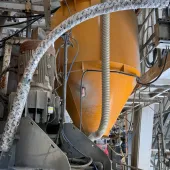Seratech create ‘green’ bricks for the future
Start-up firm produces carbon-neutral brick prototype using magnesium carbonate binder from CCMU process
SERATECH, a climate-tech start-up, have produced their first carbon-neutral brick prototype following 18 months of research funded by the Engineering and Physical Sciences Research Council (EPSRC) and Higher Education Innovation Fund (HEIF).
The brick uses a magnesium carbonate binder that is produced via Seratech’s proprietary carbon capture, mineralization, and utilization (CCMU) process and allows CO2 emissions from industry flues to be permanently stored within the built environment.
Unlike conventional clay bricks which require firing at over 1,200°C and have close to 1kg of embodied CO2 per brick, Seratech’s brick needs only to be baked at 60°C overnight before being left to cure at an ambient temperature for up to two weeks to gain full strength.
Barney Shanks, chief technical officer of Seratech, said: ‘The impact of cement emissions has been well documented but less frequently discussed are the emissions associated with clay-fired bricks of which millions are used in the UK every year – take a look at Battersea Power Station.’
To translate the concept into a commercially viable product, Seratech teamed up with architects Carmody Groarke and have been awarded a Design Exchange Partnership grant from the Arts and Humanities Research Council (AHRC). The team collaborated with structural engineers AKT II and materials specialists Local Works Studio, experimenting with different aggregate and additive combinations to improve performance and circularity.
However, the brick’s binding agent – magnesium carbonate – remains ‘the star of the show’ and what makes it a viable low-carbon solution for the construction industry. Over the next few months, the prototypes will be thoroughly tested to verify their performance against building standards.
Seratech’s technical director, Caitlin Howe, commented: ‘It’s wonderful to be working towards something that will hopefully make a difference to carbon emissions in the long run. Knowing there is scope for this product to change the entire industry is incredibly exciting and spurs you on.'
Sian Ricketts, sustainability lead at Carmody Groarke, added: ‘We’re really excited for our practice to be working with material scientists who are operating at the top of their game and foster this collaborative process. As architects, we see this as incredibly important.’










